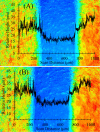Parylene Double-Layer Coated Screen-Printed Carbon Electrode for Label-Free and Reagentless Capacitive Aptasensing of Gliadin
- PMID: 38982801
- PMCID: PMC11287748
- DOI: 10.1021/acssensors.4c00875
Parylene Double-Layer Coated Screen-Printed Carbon Electrode for Label-Free and Reagentless Capacitive Aptasensing of Gliadin
Abstract
Celiac patients are required to strictly adhere to a gluten-free diet because even trace amounts of gluten can damage their small intestine and leading to serious complications. Despite increased awareness, gluten can still be present in products due to cross-contamination or hidden ingredients, making regular monitoring essential. With the goal of guaranteeing food safety for consuming labeled gluten-free products, a capacitive aptasensor was constructed to target gliadin, the main allergic gluten protein for celiac disease. The success of capacitive aptasensing was primarily realized by coating a Parylene double-layer (1000 nm Parylene C at the bottom with 400 nm Parylene AM on top) on the electrode surface to ensure both high insulation quality and abundant reactive amino functionalities. Under the optimal concentration of aptamer (5 μM) used for immobilization, a strong linear relationship exists between the amount of gliadin (0.01-1.0 mg/mL) and the corresponding ΔC response (total capacitance decrease during a 20 min monitoring period after sample introduction), with an R2 of 0.9843. The detection limit is 0.007 mg/mL (S/N > 5), equivalent to 0.014 mg/mL (14 ppm) of gluten content. Spike recovery tests identified this system is free from interferences in corn and cassava flour matrices. The analytical results of 24 commercial wheat flour samples correlated well with a gliadin ELISA assay (R2 = 0.9754). The proposed label-free and reagentless capacitive aptasensor offers advantages of simplicity, cost-effectiveness, ease of production, and speediness, making it a promising tool for verifying products labeled as gluten-free (gluten content <20 ppm).
Keywords: Parylene AM; Parylene C; aptamer; gluten; insulation layer.
Conflict of interest statement
The authors declare no competing financial interest.
Figures









Similar articles
-
Sensitive gluten determination in gluten-free foods by an electrochemical aptamer-based assay.Anal Bioanal Chem. 2015 Aug;407(20):6021-9. doi: 10.1007/s00216-015-8771-6. Epub 2015 Jun 6. Anal Bioanal Chem. 2015. PMID: 26048055
-
Portable gliadin-immunochip for contamination control on the food production chain.Talanta. 2015 Sep 1;142:57-63. doi: 10.1016/j.talanta.2015.04.040. Epub 2015 Apr 23. Talanta. 2015. PMID: 26003692
-
Fabrication of magnetically assembled aptasensing device for label-free determination of aflatoxin B1 based on EIS.Biosens Bioelectron. 2018 Jun 15;108:69-75. doi: 10.1016/j.bios.2018.02.043. Epub 2018 Mar 21. Biosens Bioelectron. 2018. PMID: 29501049
-
Magneto immunosensor for gliadin detection in gluten-free foodstuff: towards food safety for celiac patients.Biosens Bioelectron. 2011 Sep 15;27(1):46-52. doi: 10.1016/j.bios.2011.06.006. Epub 2011 Jul 20. Biosens Bioelectron. 2011. PMID: 21764291
-
Role of Estradiol Hormone in Human Life and Electrochemical Aptasensing of 17β-Estradiol: A Review.Biosensors (Basel). 2022 Dec 2;12(12):1117. doi: 10.3390/bios12121117. Biosensors (Basel). 2022. PMID: 36551086 Free PMC article. Review.
References
-
- Guennouni M.; Admou B.; El khoudri N.; Bourrhouat A.; Zogaam L. G.; Elmoumou L.; Hilali A. Gluten contamination in labelled gluten-free, naturally gluten-free and meals in food services in low-middle- and high-income countries: a systematic review and meta-analysis. Br. J. Nutr. 2022, 127, 1528–1542. 10.1017/S0007114521002488. - DOI - PubMed
-
- Woldemariam K. Y.; Yuan J.; Wan Z.; Yu Q.; Cao Y.; Mao H.; Liu Y.; Wang J.; Li H.; Sun B. Celiac Disease and Immunogenic Wheat Gluten Peptides and the Association of Gliadin Peptides with HLA DQ2 and HLA DQ8. Food Rev. Int. 2022, 38, 1553–1576. 10.1080/87559129.2021.1907755. - DOI
Publication types
MeSH terms
Substances
LinkOut - more resources
Full Text Sources

